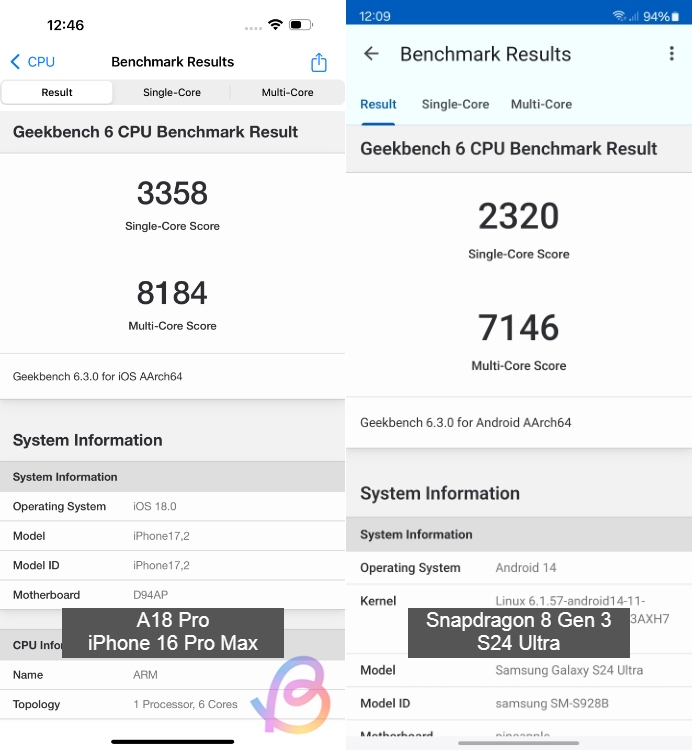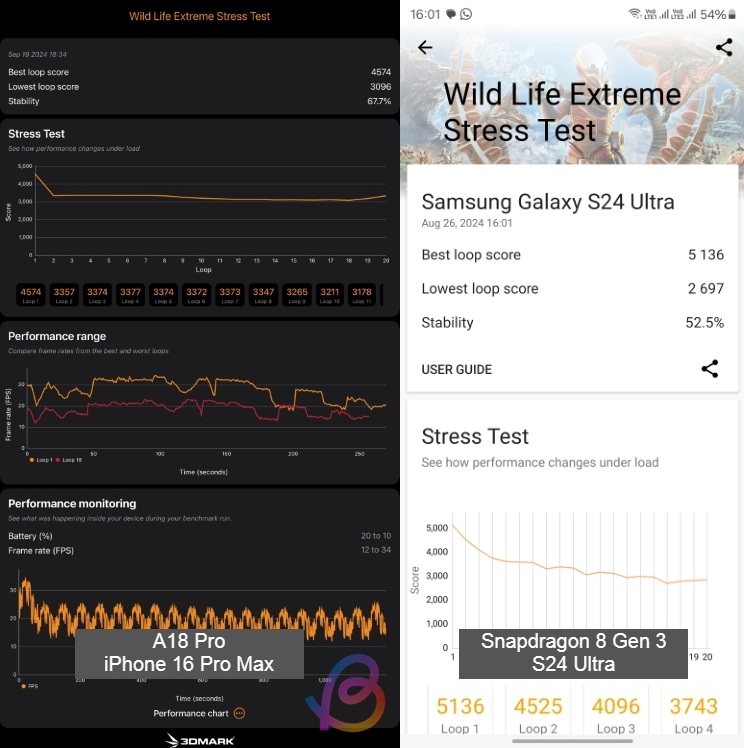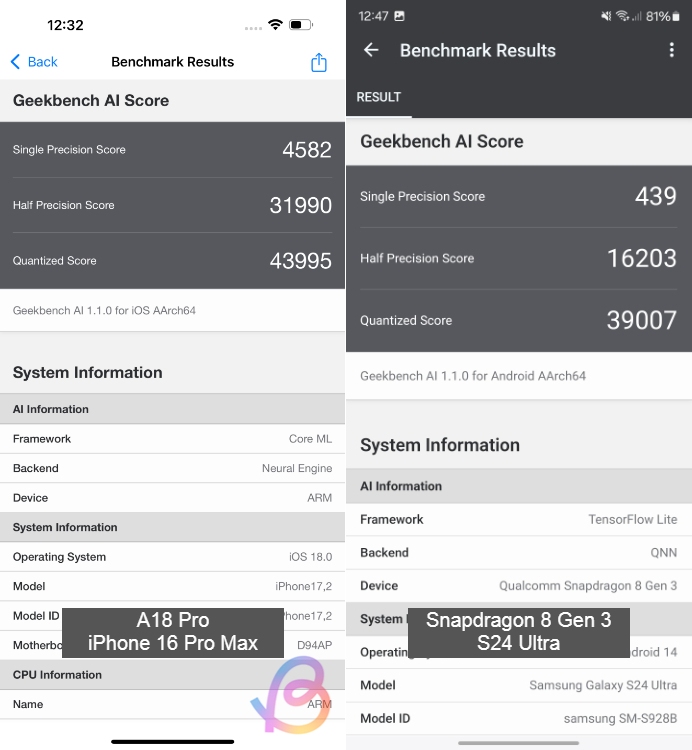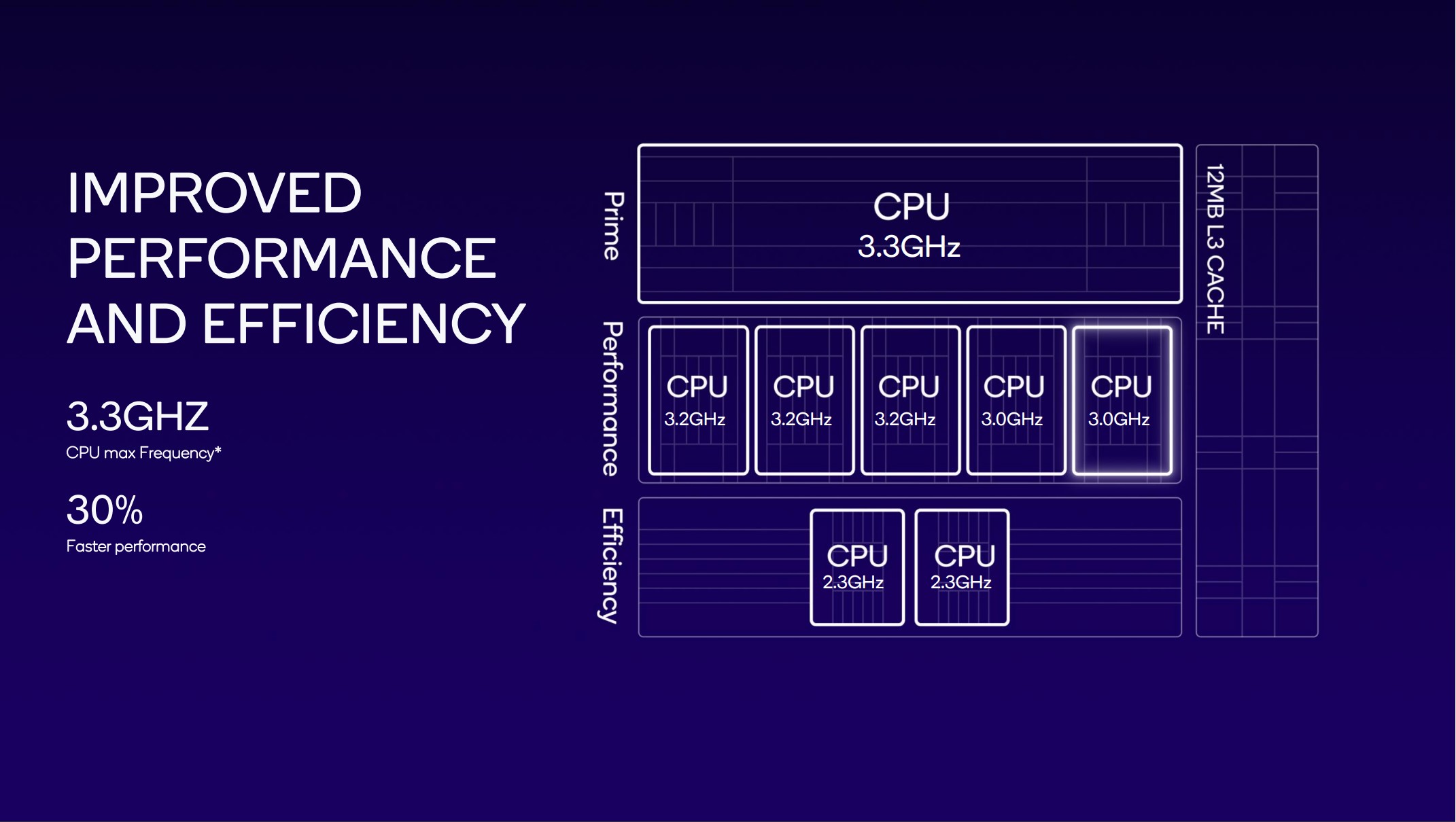Apple has released its flagship phones, the iPhone 16 Pro and 16 Pro Max, powered by the powerful A18 Pro chipset. The new A18 Pro chipset has grabbed headlines for delivering faster performance and unrivaled efficiency. But where does it stack up against the Snapdragon 8 Gen 3 which is still the leading chipset in the Android world? To find the answer, let’s go through our detailed benchmark comparison between A18 Pro and Snapdragon 8 Gen 3.
A18 Pro vs Snapdragon 8 Gen 3: Specifications
| Specifications | Apple A18 Pro | Snapdragon 8 Gen 3 |
|---|---|---|
| CPU | Six-core CPU (2+4) | Octa-core, Kryo CPU (1+3+2+2) |
| CPU Cores | 2x 4.05GHz Performance cores 4x 2.42GHz Efficiency cores | 1x 3.3GHz (Cortex-X4) 3x 3.2GHz (Cortex-A720) 2x 3.0GHz (Cortex-A720) 2x 2.3GHz (Cortex-A520) |
| Process Technology | TSMC’s 3nm process (N3E) | TSMC’s 4nm process (N4P) |
| GPU | Apple 6-core GPU Hardware-accelerated Ray Tracing | Adreno GPU 750 HW Ray Tracing, AFME 2.0 Unreal Engine 5 Lumen |
| Memory Support | LPDDR5X, up to 7500 MT/s | LPDDR5X, up to 4.8GHz |
| Machine Learning and AI | 16-core Neural Engine; 35 TOPS | New Hexagon AI Engine Run AI models up to 10B parameters |
| Modem | Snapdragon X75 5G modem Up to 10 Gbps Peak Download Up to 3.5 Gbps Peak Upload | Snapdragon X75 5G modem Up to 10 Gbps Peak Download Up to 3.5 Gbps Peak Upload |
| Connectivity | Wi-Fi 7, Bluetooth 5.3 | Wi-Fi 7, Bluetooth 5.4, LE |
A18 Pro vs Snapdragon 8 Gen 3: Geekbench 6 CPU

In the Geekbench CPU test, the A18 Pro scores 3,358 in single-core and 8,184 in multi-core. The A18 Pro CPU is based on the Armv9.2a architecture and packs two new SME units (ML accelerators) which helps the CPU achieve slightly better scores on the latest Geekbench 6.3 benchmark that got SME support recently.
In comparison, last year’s Snapdragon 8 Gen 3 scored 2,320 in single-core and 7,146 in multi-threaded tasks. The CPU is based on the older Armv8 architecture, hence there is no SME support.
In summary, the A18 Pro CPU is around 45% faster than the Snapdragon 8 Gen 3 in single-core tasks. And in terms of multi-core performance, it’s 14% faster. Since the Snapdragon 8 Gen 3 packs eight CPU cores (A18 Pro has six), the gap in multi-core performance is not that huge.
A18 Pro vs Snapdragon 8 Gen 3: AnTuTu Benchmark

In the AnTuTu benchmark, the A18 Pro and Snapdragon 8 Gen 3 perform along the same lines. In our test, the A18 Pro scored 1,826,016 points and the Snapdragon 8 Gen 3 achieved 1,810,792 points. The CPU performance is nearly identical, but in the GPU department, the A18 Pro delivers 10% better graphics performance.
| AnTuTu Benchmark | A18 Pro | Snapdragon 8 Gen 3 |
|---|---|---|
| AnTuTu Score | 1,816,016 | 1,810,792 |
| CPU | 451,848 | 453,584 |
| GPU | 728,942 | 665,619 |
| Memory | 268,756 | 403,474 |
| UX | 366,470 | 288,115 |
A18 Pro vs Snapdragon 8 Gen 3: 3DMark Wild Life Extreme Stress Test

Next, in our 3DMark Wild Life Extreme Stress test, the 6-core A18 Pro GPU got the best loop score of 4,574 points and the lowest loop score of 3,096 points with a stability of 67.7%. Whereas the Adreno 750 GPU on Snapdragon 8 Gen 3 scored better in the first loop with a score of 5,136 points. But after multiple rounds, the lowest score came down to 2,697 points. The stability stood at a lower 52.5%.
This means that Snapdragon 8 Gen 3 can quickly boost the GPU performance, but it can’t sustain the peak performance for much longer. A18 Pro, on the other hand, offers sustained graphics performance for an extended period. Put simply, the A18 Pro will offer a better gaming experience over a longer period than the Snapdragon 8 Gen 3.
| 3DMark Wild Life Extreme Stress Test | A18 Pro | Snapdragon 8 Gen 3 |
|---|---|---|
| Best loop score | 4,574 | 5,136 |
| Lowest loop score | 3,096 | 2,697 |
| Stability | 67.7% | 52.5% |
A18 Pro vs Snapdragon 8 Gen 3: Geekbench AI

Finally, we come to our Geekbench AI test that evaluates the Neural Engine/NPU. Geekbench AI was recently updated to version 1.1 which slightly improves the scores across the board. And it also added support for TensorFlow Lite and QNN framework for Android devices. The NNAPI framework has been deprecated and you finally get an apples-to-apples comparison between Android and iOS devices.
In our testing, the A18 Pro scored much better on the Single Precision (FP32) data type, achieving 4,582 points whereas the Snapdragon 8 Gen 3 could only get 439 points. The full precision format offers higher accuracy while running AI/ML tasks, but consumes more memory.
In Half Precision (FP16), the 16-core A18 Pro Neural Engine delivers 2x better performance than the Hexagon AI engine on Snapdragon 8 Gen 3. Finally, in Quantized format (INT8) which is more memory-efficient, but relatively less accurate, the A18 Pro is around 13% faster than the Snapdragon 8 Gen 3.
It’s clear that Apple is the leader in on-device AI computation. And with the new SME units in the CPU, the A18 Pro seems a far better chipset for delivering AI/ML features locally.
| Geekbench AI | A18 Pro | Snapdragon 8 Gen 3 |
|---|---|---|
| Single Precision Score | 4,582 | 439 |
| Half Precision Score | 31,990 | 16,203 |
| Quantized Score | 43,995 | 39,007 |
The Verdict
It’s evidently clear that the A18 Pro is a better chipset than the Snapdragon 8 Gen 3 in all aspects, be it the CPU, GPU, or Neural Engine/NPU. Apple has the most powerful and power-efficient CPU cores and the GPU also offers sustained graphics performance. As for on-device AI tasks, Apple has again demonstrated that it’s the leader in the industry.
Now, we need to wait for the Oryon-powered Snapdragon 8 Gen 4 that promises breakthrough performance. Based on leaks so far, Qualcomm is poised to outclass Apple in the CPU department for the first time. Snapdragon 8 Gen 4 releases next month at the Snapdragon Summit event.
Microsoft’s ‘Click To Do’ Feature Will Be Your On-Screen Assistant Every Step Of The Way
The Penguin Episode 5 Ending Explained: The Beginning Of An Unexpected Alliance
Instagram Gains Bold New Powers To Combat Sextortion Scams


